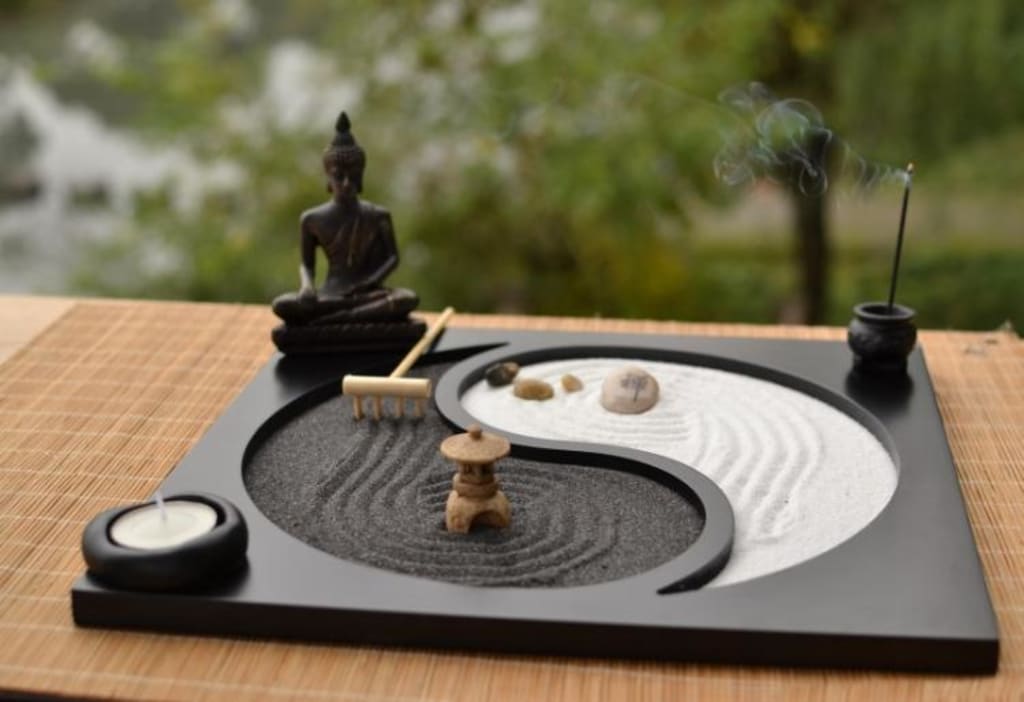Finding Zen in the Workplace
Strategies for Using Ancient Techniques Adapted for the Modern Setting

Whether it be an office job, a management position, or working remotely, one will find that continually being busy throughout the day creates a tremendous amount of stress on the body and mind. We are not a young species anymore; the way work used to get done was waking up at the crack of dawn and working the farm till dusk. Not anymore; now we have entire enterprises backed by thousands of employees who work from nine to five staring at a computer screen.
So what are the major side effects of working the modern American lifestyle? Isolation, overwork/overtime, and misidentification with the staff. These all cause different forms of stress and depression on the average worker.
Many offices now are trying to get progressive and create all-inclusive work strategies to help employees, but there are still things you can do on your own in order to make your work environment relaxing for you. The strategies come from authentic eastern techniques that have been adapted over thousands of years for modern use. Unlike what you’ve seen in videos, these techniques aren’t going to take you out of your comfort zone. These small tips can make any day easier to handle with three simple strategies.
Step #1: Exploring Your Workspace
One of the most stress-inducing problems with office space is feeling isolated. With many tasks to complete throughout the day, there isn’t much time to get out and connect with other employees. You clock in and you have an entire workday ahead of you. So, how can you get out of the same routine? Use your free time wisely and come prepared. When you do have available free time, whether it be break or lunch, don’t just stay cramped in the break room. If there are any areas of the office you may not be familiar with, seek them out and ask questions. It’s always a good idea to better know your workplace.
Be mindful of what you bring to work each day! The typical coffee and donuts has a huge impact on performance in the workplace. There are so many new grocery stores offering healthy interesting snacks to bring, and my number one recommendation is to always switch from coffee to black or green tea. These often give you the boost you need without the crash that coffee brings. The added honey is much better for you than cream and sugar! While in the organic grocery, try finding new whole grain or fruit, veggie and nut based products that will give you a natural boost to your daily routine. You’ll find yourself having much more energy throughout the day.
Step #2: Manage Your Tasks
This one seems to be a major cliché that you’ve heard time and time again in your office meetings, but I’ve got a few strategies to offer that you might not have heard of. Think to yourself, how often do we spend our time thinking to the point that racing thoughts get completely out of control? When you’re handed a stack of tasks in the morning, the immediate reaction is to collapse and not want to complete any of the work. That’s because the work is often not organized into specific time-oriented goal times. Your first thought should be to set each task with a specific time limit so you know what should be done at specific times throughout the day.
The next step is the actual working process, which can get a little challenging without practice. This is where our Zen strategies come into play. The key tenant of Zen is that when we empty our thoughts of unnecessary baggage, we find that our minds are more efficient. There are so many things going on in our daily lives that we just have to set ourselves free from, not just for the workplace, but for overall peace of mind. Argument with the wife the night before work? Boss watching your work extra closely this week? In Zen, before starting any task, you should take three to five minutes to clear your mind. This means putting down all your burdens, relaxing your shoulders, closing your eyes and breathing.
If you have never done this, it may feel strange. You may notice that when you get into this state, everything around you seems extremely noticeable because you have put all your senses into a heightened state. The goal here is using your breathing strategies to push all those external thoughts and sounds away until you get a focused grasp on the task at hand. As you breathe in, think that all the struggles you’re facing are going inward, and as you breathe out, they are all pushed out of your thoughts. Do this slowly for three to five minutes with a five second slow inhale and five second slow exhale. The idea is that upon completion, your thoughts should not be wandering. You should have a laser clear focus on your day’s tasks, which you’ve now scheduled out throughout the day.
Step #3: Connecting with Your Coworkers
For some, this may be the most difficult step of all. After all, there are infrequent times to socialize during the workday. Some are lucky enough to have laid back offices where employees can work together on tasks, but for the most part, employees tend to have to work alone. The goal here is to connect with your coworkers in a personal way, meaning, finding common ground between you on your likes and dislikes.
After all, we are all human beings who share tons of major common denominators like family, friendships, and the love of entertainment. The first encounter with someone may be hard to break the ice, but one of the easiest ways I’ve found is to blatantly make a joke about how awkward it is. The other person will usually play into the joke. Talk about simple things you know, and if the conversation is working, do your best to expand to broader topics (that you feel safe with on the first conversation!). Eventually you will be able to connect on a deeper level with your coworker, possibly even become good friends.
Once you connect with one coworker (your work bestie!) you want to try to get connected into whatever group you’re affiliated with, whether that’s your office floor, task group, etc. The best way to do this is to be vocal in group meetings. Be that person that offers up creative ideas and strategies for the company. People will notice your presence and test the waters for your personality. After the meeting is over, stay behind with one or two of the employees and discuss some of the topics talked about. What did they think about what was discussed? This is a time when you can get a personal point of view from someone who might not have felt comfortable vocalizing their true opinion during the meeting.
Following these strategies will help you make a lot of cool connections in your workplace. After all, Zen is not some wacky Eastern method that nobody’s heard about. There are many complex ways to practice Zen in the higher levels, and you can really find ways of heightening your senses and having an overall greater connection with nature and your higher power. Zen has been refined for thousands of years and is practiced widely around the world today. These are simply some very basic strategies to get out there and start getting more relaxed in your workplace. By using these strategies you will find a much better energy and feel a more positive work environment in the future!
About the Creator
Tyler Norris
I'm an author who loves whiskey and good conversation. I have two books of poetry and love meditation and spirituality. You can find me on Facebook as Tyler Norris, Author and on Instagram as @collegpoet64.






Comments
There are no comments for this story
Be the first to respond and start the conversation.